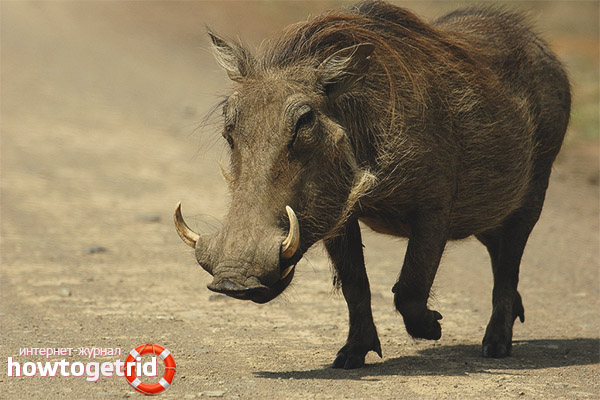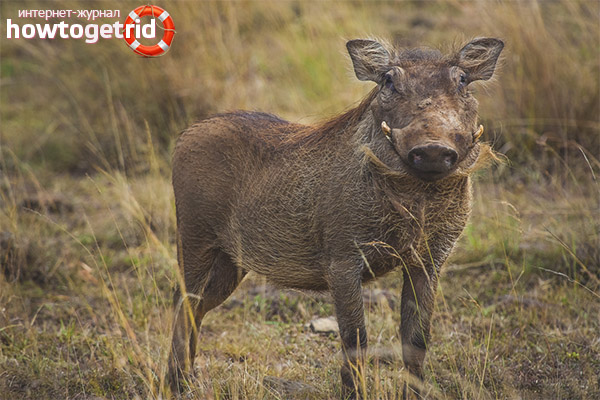The content of the article
Everything in the warthog is unusual, starting from the exterior and ending with lifestyles. This animal, living on the African continent, has gained fame thanks to the cartoon "The Lion King" - many fell in love with the image of the cheerful Chef Pumbaa. How much does a cartoon character correspond to real warthogs?
Appearance
A warthog is a type of wild boar and belongs to the cloven-hoofed squad. Like most other wild pigs, it has long fangs sticking up from its mouth. They reach a length of half a meter and are a means to intimidate the enemy: due to the shape of the fangs, the warthog is unlikely to be able to pierce someone with them. The animal has a large head with a blunt elongated muzzle. From the top of the head begins a mane of red coarse hair, stretching to the end of the back.
The warthog got its name for subcutaneous fat growths located on the sides of its muzzle. There are six such growths, and they really resemble huge warts. The warthog has small eyes located near the forehead. Such a high landing of the organs of vision provides the animal with a good overview of the area.
Warthogs have a massive body. Height at the withers 65-70 cm, weight - up to 100 kg for males and 70 kg - for females. The skin is dyed gray and covered with long sparse bristles. Its shade ranges from brown to light gray. The tail is thin and decorated with a slight thickening at the end. When a warthog is afraid or wants to run away, he raises his tail up. For this habit, he received the humorous nickname Radio Africa.
Lifestyle & Reproduction
Warthogs are common throughout sub-Saharan Africa. They always live in the same locality and do not make transitions without critical need. They have permanent dens, which is uncharacteristic of wild pigs. They prefer to settle in shrubbery savannahs, staying away from fields and forests. Warthogs are active during the day, hiding at noon from the heat in their burrows.
Warthogs are herd animals and live in groups of 4-16 individuals. As a rule, such a herd consists of adult females and children, while males usually keep alone. Warthogs dig holes for themselves, in which the whole family is compactly placed: children crawl into it with their muzzle forward, and adult individuals back away so that their fangs are near the entrance to the hole. Then they will be able to intimidate the passing enemies, the main of which is the lion. Sometimes warthogs do not dig housing themselves, but occupy ready-made burrows of porcupines. For independent digging of holes, they use a snout and fangs, which dig the soil.
Warthogs feed on plant foods by eating grass and shrubs. To get nutritious roots, animals descend to the forelimbs and start tearing the earth. They dilute their diet with berries and tree bark. They replenish the supply of protein by eating insects. Do not disdain from time to time to eat carrion left after predators.
An interesting feature of warthogs is to bend their front legs at the knees when performing various actions. They take this position when they drink water, dig holes and conduct ritual battles. As a result, in mature individuals, corns are formed on the forelimbs. By the way, about ritual battles: they are not uncommon among males during the mating season. Warthogs arrange a contest for the attention of the females, resting their foreheads and trying to move the opponent out of place. At the same time, fangs animals are not allowed to move, preferring to do only physical strength.
The female carries the cubs for about 6 months. It is still not known exactly how many piglets are born in the litter. According to one version, there are two or three of them. On the other, the female gives birth to 6-8 cubs. But since she has only 4 nipples, only half of the newborns survive.
Small warthogs do not yet have fangs and with their pinkish skin resemble domestic piglets. From the very first days, the female can leave her cubs for the whole day, going off in search of food. The mother returns only twice a day to feed the piglets. After a while, the growing warthogs begin to get out of the hole and accompany the female on her campaigns, learning to live independently. At the age of 1 year, warthogs are ready to live separately from the parent and provide themselves with food.
The average life expectancy of warthogs is 15-16 years. In captivity, they live a little longer.
Character

The terrible appearance of warthogs is misleading. In fact, these are rather calm animals that do not show aggression first. They behave cautiously, trying to avoid predator habitats. If possible, the warthog will try to escape rather than engage in open battle. If the animal is weak or wounded, then it will defend to the last.
Warthogs are timid and try to hide even from smaller animals. A wild pig also tries not to show itself to humans, which is why this species is quite difficult for zoologists to study.
Relations with other species
Warthogs interact with other animal species. For example, striped mongooses spend a lot of time combing parasites from the boar wool and eating them. During this lesson, warthogs lie still.
Another example of such a symbiosis is small birds that settle next to the holes of wild pigs. Warthogs attract a lot of insects and parasites, which serve as the main source of food for birds. Using the warthog’s dwelling as a feeding trough, the feathered birds warn the inhabitants of the hole about the impending danger.
Wild pigs have enough enemies, among which are lions and leopards. Also dangerous for warthogs are hyenas. Despite the significant difference in size, hyenas prey on young growth while the mother leaves the hole. The way in which hyenas hunt is influenced. They stray into a flock and surround the victim, running near it and biting from time to time. Such actions harass large animals, and they prefer to surrender. Therefore, an organized flock of hyenas can deal with a mature warthog.
Another threat to piglets is birds of prey. They track the victim from a height and wait for the female with the children to move a sufficient distance from the hole, and then dive down.
Safety
Warthogs are not an endangered species and are not listed in the Red Book. Despite this, the number of animals in some regions is declining. This is due to the local population who hunt warthogs for meat. Warthogs are also hunted due to the fact that they destroy plantations and fields, digging holes for them. And diseases carried by wild pigs are transmitted to domestic animals, causing cattle death.
To save the warthog allow long legs. Despite the fact that usually a warthog passes no more than 5 km in an hour, when a threat occurs he is able to flee at a speed of 50 km / h. While running, they lift their tail, signaling to other animals about the danger. Their neck is very mobile, and even during the chase, warthogs can lift their heads up high and turn it around, which other pigs cannot do.
Interesting Facts
- Despite the fact that warthogs do not use long fangs for defense, they can pierce the attacker's skin with their lower fangs, which also stick out of the mouth with the tip pointing up.
- The warthog is the only wild pig digging holes.
- The range of sounds made by the warthog is very wide. This animal can grunt, squeal and snort, expressing a variety of feelings. Wild pigs communicate in this way both with each other and sound signals to other species.
- In recent years, there have been more frequent cases when warthogs settle in urban areas. This allows them to have access to landfills and get food from there.
- There was a case at the Warsaw Zoo when a quarantined warthog escaped to local forests. Despite the fact that the European climate does not resemble the African one, the animal lived among trees for a long time, leaving specific traces of its presence.
Video: warthog (Phacochoerus africanus)











Submit